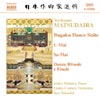Matsudaira Theme and Variations for Piano and Orchestra
Neo-classicism meets ancient Eastern tradition in music of grace and beauty
View record and artist detailsRecord and Artist Details
Composer or Director: Yoritsune Matsudaira
Genre:
Orchestral
Label: Naxos
Magazine Review Date: 2/2005
Media Format: CD or Download
Media Runtime: 71
Mastering:
Stereo
DDD
Catalogue Number: 8 555882

Tracks:
| Composition | Artist Credit |
|---|---|
| Theme and Variations |
Yoritsune Matsudaira, Composer
Ichiro Nodaira, Piano Ken Takaseki, Conductor Osaka Century Orchestra Yoritsune Matsudaira, Composer |
| Danse sacrée et Danse finale |
Yoritsune Matsudaira, Composer
Ken Takaseki, Conductor Osaka Century Orchestra Yoritsune Matsudaira, Composer |
| Sa-Mai |
Yoritsune Matsudaira, Composer
Ken Takaseki, Conductor Osaka Century Orchestra Yoritsune Matsudaira, Composer |
| U-Mai |
Yoritsune Matsudaira, Composer
Ken Takaseki, Conductor Osaka Century Orchestra Yoritsune Matsudaira, Composer |
Author: bwitherden
Yoritsune Matsudaira (1907-2001) was descended both from the Shogun rulers of Japan and the Fujiwaras, among the most powerful factions at the Imperial Court between the 7th and 12th centuries, but in his formative years he was surrounded by liberal elements opposed to the pervading mood of nationalism.
Like Takemitsu after him, he was repelled by Japanese militarism and studied European music, particularly Debussy and Satie. He read French literature at university but was inspired to take up music professionally after hearing pianist Henri Gil-Marchex. Throughout the 1930s he wrote in a French-influenced neo-Classical style, then, apart from a few brass band works, stopped composing during the Second World War, being out of sympathy with the patriotic art required at that time. He was, however, extending his studies into Japanese forms, finding renewed inspiration in the ancient Gagaku (court music) tradition.
Theme and Variations (1951), the most approachable and out-going work here, illustrates Matsudaira’s melding of Gagaku and neo-classicism. The other pieces, arranged as a suite for this recording, date from the late 1950s. By then Matsudaira was experimenting with serialism and aleatoric techniques. (Morihide Katayama‘s comprehensive and informative notes observe: ‘Gagaku is equipped with many elements that may fit with avant-garde music.’ Similarly, some of the most extreme and experimental electro-acoustic, electronic and improvising Japanese musicians of the past two decades use traditional instruments associated with Gagaku, such as the sho and biwa, types of mouth-organ and lute respectively.)
Matsudaira‘s admirers have included Takemitsu, Messiaen and Boulez, and his influence on Boulez in particular is clear from these ritualistic works, with their stern, rather cold yet mesmerising grace and beauty. With its convincing, suitably ceremonial performances and atmospheric recorded ambience, this is yet another fascinating release to add to Naxos’s roll of honour.
Like Takemitsu after him, he was repelled by Japanese militarism and studied European music, particularly Debussy and Satie. He read French literature at university but was inspired to take up music professionally after hearing pianist Henri Gil-Marchex. Throughout the 1930s he wrote in a French-influenced neo-Classical style, then, apart from a few brass band works, stopped composing during the Second World War, being out of sympathy with the patriotic art required at that time. He was, however, extending his studies into Japanese forms, finding renewed inspiration in the ancient Gagaku (court music) tradition.
Theme and Variations (1951), the most approachable and out-going work here, illustrates Matsudaira’s melding of Gagaku and neo-classicism. The other pieces, arranged as a suite for this recording, date from the late 1950s. By then Matsudaira was experimenting with serialism and aleatoric techniques. (Morihide Katayama‘s comprehensive and informative notes observe: ‘Gagaku is equipped with many elements that may fit with avant-garde music.’ Similarly, some of the most extreme and experimental electro-acoustic, electronic and improvising Japanese musicians of the past two decades use traditional instruments associated with Gagaku, such as the sho and biwa, types of mouth-organ and lute respectively.)
Matsudaira‘s admirers have included Takemitsu, Messiaen and Boulez, and his influence on Boulez in particular is clear from these ritualistic works, with their stern, rather cold yet mesmerising grace and beauty. With its convincing, suitably ceremonial performances and atmospheric recorded ambience, this is yet another fascinating release to add to Naxos’s roll of honour.
Discover the world's largest classical music catalogue with Presto Music.

Gramophone Digital Club
- Digital Edition
- Digital Archive
- Reviews Database
- Full website access
From £8.75 / month
Subscribe
Gramophone Full Club
- Print Edition
- Digital Edition
- Digital Archive
- Reviews Database
- Full website access
From £11.00 / month
Subscribe
If you are a library, university or other organisation that would be interested in an institutional subscription to Gramophone please click here for further information.




